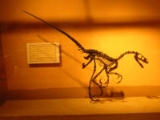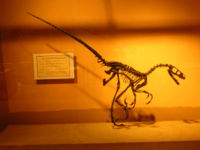
1978 in paleontology
Encyclopedia
Paleontology, palaeontology or palæontology (from Greek: paleo, "ancient"; ontos, "being"; and logos, "knowledge") is the study of prehistoric
life forms on Earth through the examination of plant and animal fossil
s. This includes the study of body fossil
s, tracks (ichnite
s), burrow
s, cast-off parts, fossilised faeces
(coprolite
s), palynomorph
s and chemical residues. Because mankind has encountered fossils for millennia, paleontology has a long history both before and after becoming formalized as a science. This article records significant discoveries and events related to paleontology that occurred in the year 1978.
's dinosaur genera list and Dr. Jeremy Montague's dinosaur genus database.
er="0" style= height:"100%" align="right" style="background:transparent;">
Prehistory
Prehistory is the span of time before recorded history. Prehistory can refer to the period of human existence before the availability of those written records with which recorded history begins. More broadly, it refers to all the time preceding human existence and the invention of writing...
life forms on Earth through the examination of plant and animal fossil
Fossil
Fossils are the preserved remains or traces of animals , plants, and other organisms from the remote past...
s. This includes the study of body fossil
Fossil
Fossils are the preserved remains or traces of animals , plants, and other organisms from the remote past...
s, tracks (ichnite
Ichnite
An ichnite is a fossilised footprint. This is a type of trace fossil. Over the years, many ichnites have been found, around the world, giving important clues about the behaviour of the animals that made them...
s), burrow
Burrow
A burrow is a hole or tunnel dug into the ground by an animal to create a space suitable for habitation, temporary refuge, or as a byproduct of locomotion. Burrows provide a form of shelter against predation and exposure to the elements, so the burrowing way of life is quite popular among the...
s, cast-off parts, fossilised faeces
Feces
Feces, faeces, or fæces is a waste product from an animal's digestive tract expelled through the anus or cloaca during defecation.-Etymology:...
(coprolite
Coprolite
A coprolite is fossilized animal dung. Coprolites are classified as trace fossils as opposed to body fossils, as they give evidence for the animal's behaviour rather than morphology. The name is derived from the Greek words κοπρος / kopros meaning 'dung' and λιθος / lithos meaning 'stone'. They...
s), palynomorph
Palynomorph
Palynomorph is the geological term used to describe a particle of a size between five and 500 micrometres, found in rock deposits and composed of organic material such as chitin, pseudochitin and sporopollenin...
s and chemical residues. Because mankind has encountered fossils for millennia, paleontology has a long history both before and after becoming formalized as a science. This article records significant discoveries and events related to paleontology that occurred in the year 1978.
Newly named dinosaurs
Data courtesy of George OlshevskyGeorge Olshevsky
George Olshevsky is a freelance editor, writer, publisher, amateur paleontologist, and mathematician living in San Diego, California.Olshevsky maintains the comprehensive online Dinosaur Genera List...
's dinosaur genera list and Dr. Jeremy Montague's dinosaur genus database.
| Name | Status | Authors | Notes | Images | |
|---|---|---|---|---|---|
| Amtosaurus Amtosaurus Amtosaurus is a genus of ornithischian dinosaur based on a fragmentary skull collected from the Upper Cretaceous Bayanshiree Svita Formation of Mongolia and originally believed to represent an ankylosaurid. Hadrosaurid affinities have also been suggested... |
Nomen dubium Nomen dubium In zoological nomenclature, a nomen dubium is a scientific name that is of unknown or doubtful application... . |
|
|
  |
|
| Coloradia Coloradia Coloradia is a genus of moths of the family Saturniidae. There are nine described species found in Mexico and eastern North America.These are generally large moths, predominantly grey in colour. The larvae usually feed on pines and members of the genus are commonly called pinemoths, although... |
Valid taxon |
|
PReoccupied by Blake 1863. Renamed Coloradisaurus. |
||
| Lesothosaurus Lesothosaurus Lesothosaurus is an herbivorous ornithischian dinosaur. It was named by paleontologist Peter Galton in 1978, the name meaning "lizard from Lesotho". The genus is monotypic, having only one valid species, Lesothosaurus diagnosticus, within the genus.... |
Valid taxon Possible junior synonym of Fabrosaurus Fabrosaurus Fabrosaurus ) was a genus of herbivorous dinosaur which lived during the Early Jurassic . As the only fossil known of it is a partial jawbone with three teeth, Fabrosaurus is a nomen dubium and may in fact be the same as Lesothosaurus.Fabrosaurus was around 1 meter long... . |
|
|||
| Micropachycephalosaurus Micropachycephalosaurus Micropachycephalosaurus is a monotypic genus of ornithischian dinosaur. It lived in Shandong Province, China during the Late Cretaceous period . The incomplete skeleton of the single specimen was found on a cliff southwest of Laiyang... |
Valid taxon |
Dong Zhiming Dong Zhiming , from the Institute of Vertebrate Paleontology and Paleoanthropology in Beijing, is one of China's leading paleontologists. He began working at the IVPP in 1962, learning from Yang Zhongjian who was director at the time... |
|||
| Ohmdenosaurus Ohmdenosaurus Ohmdenosaurus is the name given to a genus of herbivorous dinosaur from the Early Jurassic. It was a very small perhaps vulcanodontid sauropod which lived in Germany... |
Valid taxon |
|
|||
| "Roccosaurus" | Nomen nudum Nomen nudum The phrase nomen nudum is a Latin term, meaning "naked name", used in taxonomy... . Junior synonym of Melanorosaurus Melanorosaurus Melanorosaurus , is a genus of basal sauropodomorph dinosaur that lived during the Late Triassic period. A herbivore from South Africa, it had a large body and sturdy limbs, suggesting it moved about on all fours... . |
van Heerden vide:
|
|
||
| Saurornitholestes Saurornitholestes Saurornitholestes is a genus of carnivorous dromaeosaurid theropod dinosaur from the late Cretaceous of Alberta, Montana and New Mexico.... |
Valid taxon |
Hans-Dieter Sues Hans-Dieter Sues is a German-born paleontologist who is Senior Scientist and Curator of Vertebrate Paleontology at the National Museum of Natural History of the Smithsonian Institution in Washington, DC. He received his education at Johannes Gutenberg-Universität Mainz , University of Alberta, and... |
|||
| Yangchuanosaurus Yangchuanosaurus Yangchuanosaurus was a theropod dinosaur that lived in China during the late Oxfordian stage of the Late Jurassic, and was similar in size and appearance to its North American contemporary, Allosaurus... |
Valid taxon |
Dong Zhiming Dong Zhiming , from the Institute of Vertebrate Paleontology and Paleoanthropology in Beijing, is one of China's leading paleontologists. He began working at the IVPP in 1962, learning from Yang Zhongjian who was director at the time... , |
|
||
New taxa
| s="wikitable sortable" align="center" width="100%"> | ||||
| Name | Status | Authors | Notes | |
|---|---|---|---|---|
Geosternbergia Geosternbergia Geosternbergia from the Late Cretaceous geological period of North America, was one of the largest pterosaur genera and had a wingspan of up to .-Description:... |
Valid |
Miller |
||
Peteinosaurus Peteinosaurus Peteinosaurus was a prehistoric reptile genus belonging to the Pterosauria. It lived in the late Triassic period in the middle Norian .-Name:... |
Valid |
Wild |
||
Humans
- A paleoanthropological team led by Mary LeakeyMary LeakeyMary Leakey was a British archaeologist and anthropologist, who discovered the first skull of a fossil ape on Rusinga Island and also a noted robust Australopithecine called Zinjanthropus at Olduvai. For much of her career she worked together with her husband, Louis Leakey, in Olduvai Gorge,...
finds 3.5 million year old human footprints.

